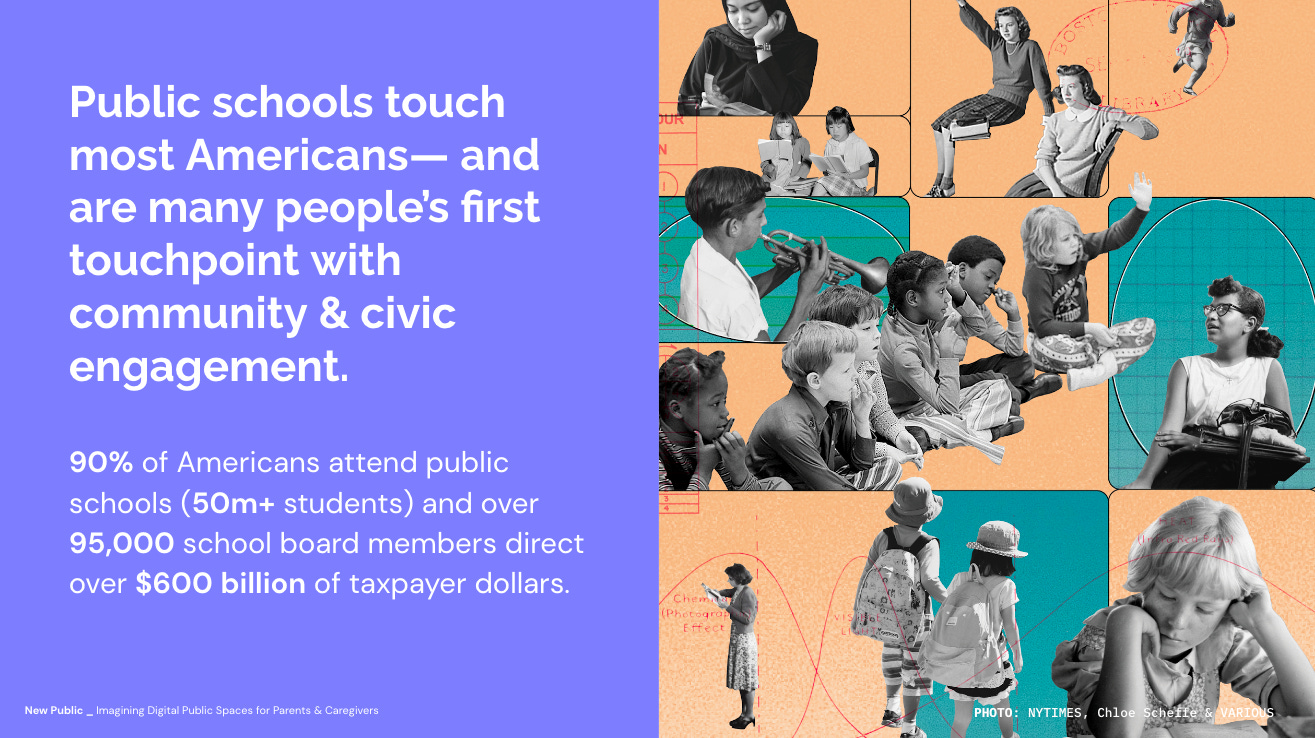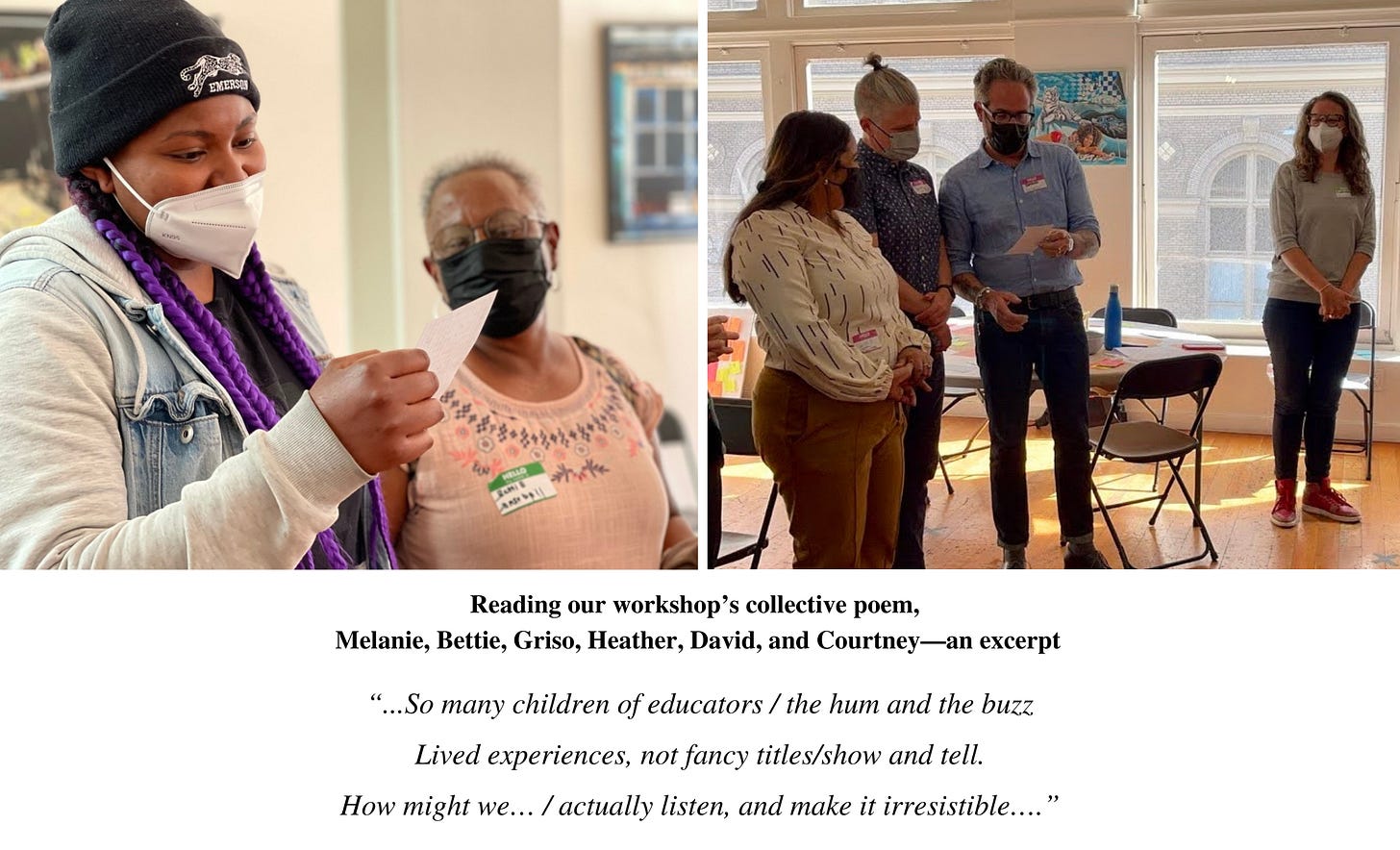🍏 Back to School Lessons: Designing together is about learning together
How imagining digital public spaces for school communities can support healthy democracy
As we settle into fall, our co-director, Eli Pariser, and design collaborator, Melanie Kahl, take us back to the classroom to explore schools as a site for healthy digital space.
One of our goals at New_ Public is to begin imagining what new digital public spaces might look like. We’re starting by partnering with communities in various spheres (faith, healthy, civic engagement) to better understand what flourishing looks like—and where there are critical gaps to imagine new tools.
In many ways, the topic of our first New_ Public “sprint” was obvious. When you care about democratic society and healthy pluralistic communities— how can we not start with schools? 90% of Americans attend public schools (50m+ students). Public schools have over 95,000 school board members direct that direct over $600 billion of taxpayer dollars. Schools are the country's largest community effort and one of our most public, public institutions – in ways that are powerful and, often, very unjust.
Schools are places of hope but are also places where we experience deep divides up close— economic stratification, racial segregation, and polarized conflict.
Yet the digital tools and structures that exist around school communities are designed for administrators more than for caregivers or equitable community-building. Our sprint focused on the opportunity to weave the community around our classrooms—between families and caregivers—and where digital tools might help.
Oakland, CA: A microcosm for urban school communities
To understand more deeply, we collaborated with a group of parents, caregivers, and school leaders in Oakland, California—the second most racially diverse city in the nation. We were mindfully connected by our friend and local parent, Courtney Martin. Her insightful book, Learning in Public, helped us think through the dynamics of the local school community and national context—especially during a pandemic.
This sprint was an opportunity to learn how caregivers created supportive, joyful, and engaged communities—and where new digital tools might fill gaps. We worked with our thoughtful design research partners, Reboot, to guide our discovery process and a facilitator (👋) with roots in designing schools. After over 20 conversations with caregivers, educators, & advocates, we hosted a series of workshops to explore potential concepts around the most promising opportunities.
We’ll share more on that soon— but why did we start with caregivers and schools?

Rebuilding civic spirit: School communities can be local sites for practicing civic engagement
When we think about the democratic value of public schools, we often focus on students’ equal opportunity and civic education. But the adults around schools can be part of this democratic project too. In theory, schools can be places where families learn to engage communally too— running for office, volunteering meaningfully, and sparking diverse friendships. The web of relationships around a school can foster or fracture a collective spirit and foundation of civic engagement.
In practice, how parents engage often exacerbates marginalization and alienation. Healthy civic conversations have become fraught. Non-white, non-English speaking parents are often culturally and politically marginalized. (White children make up less than half the student population, and white parents take up nearly 80% of school board seats.) Social media echo chambers, paired with the nationalization of media, put an accelerant on local culture wars.
If our digital public spaces have contributed to fraying, maybe they also have an opportunity to support it. Here’s what’s encouraging—small strides in representation have a huge impact on communities. How might digital tools enable participation—by making information more accessible, lightweight, and culturally relevant?

Digital community infrastructure: Families fall in the gap between a category and a platform
Our friends and funders at the Siegel Family Endowment recently released a report on school infrastructure. It’s multidimensional—comprising the digital, physical, and social. Just as physical school infrastructure is falling short (earning a D+ on America’s Infrastructure Report Card), the digital spaces around schools need repair. Families and caregivers fall into a distinct digital infrastructure gap—between institutional edtech and the wilds of social media.
Taking America’s schools online overnight wasn’t easy. The pandemic exposed the weaknesses of digital infrastructure—and our collective creativity. On social media, communities and caregivers got creative to fill the gaps. We kept arts alive on Instagram—hosting daily storytime and drawing together. Parents took charge of school communications on Whatsapp. However, misinformation ran rampant in online communities, revealing troubling adjacencies between parents and conspiracy groups. This creative “duct tape” offers design inspiration and highlights platform limitations.
We’re curious about this gap between formal and social platforms—and caregivers were too. Community members pitched “Parent Cubed”— a souped-up version of the school communication platform, ParentSquare—but their version centered on mutual aid and classroom communications. How might we encourage more investment in community-driven tools? Although edtech got a pandemic investment bump, most dollars went to course management or consumer offerings.

Learning forward: Schools are a site to reknit a sense of trust through relationships
If tech companies have been eroding trust by rapidly scaling platforms to drive individual engagement. Schools offer an alternative way to think of scale—holistically. What does it mean to design for the scale of a healthy community? Perhaps, this is the lens we need at this moment. Maria Ressa, Nobel Prize winner, seems to think so— “It must be a whole society approach to restore trust.”
And designing together can be a precarious endeavor. Courtney reflects:
“And let me be clear: asking people to gather and imagine is a vulnerable thing, especially if they’re coming from a historically marginalized background...It takes trust to believe that there could be an online space that doesn’t intentionally addict, surveil, or exploit you.”
Trust is embodied. It lives in relationships and experiences. It calls us to think about how we design as much as what we design together. And this experience allowed us to learn how New_ Public wants to show up in this work.
Looking forward, we’re thinking about how New_ Public’s Community Lab offers a scale for building those new muscles together. We’re still exploring what this might look like. Here are some questions we’re bringing with us:
What does it look like to design with care? As we get more creative with participatory approaches, how can we be mindful of the relational tending and trust that creates safety for folks to imagine together? How do we see and value this?
What does it look like to prototype quickly and mindfully? It’s hard to talk about tools and ways of being together that may not exist. What are ways to bring artifacts and prototypes into the process to play together?
How can we build from bright spots and root in the wisdom of community practitioners? Communities are exceptionally creative and wise. Often the solutions exist, but designers and product teams aren’t listening and studying that innovation up close. What are models that center and value that wisdom in the design of new tools?
How can the Community Lab be a “third place” for community, media, and technology to collaborate together? We’re New Public— we love seeing what makes our places thrive. If the process of design were a place, what would it look like? How can we build better benches, sandboxes, murals, and parks along the way?
…what would you add?
We’re grateful for the trust and deep wisdom of collaborators and our community collaborators. We look forward to sharing more of their stories, insights, creativity, and voices later this fall.
— Eli & Melanie
You’re invited…
Later this month, we’re inviting collaborators and close members of the New_ Public community to a Virtual “Show & Tell” to share back and explore together. This will be a relatively small group consisting of a balanced mix of practitioners, funders, researchers, and other New_ Public peers. Space is limited. If you’ve noticed something exciting in online school communities that you’d like to share or have specific expertise in this space, please fill out this event interest form to join us. We will confirm spots and event details via email.
Community Corkboard
Schools as Infrastructure — The Siegel Family Endowment just published their latest whitepaper, Schools as Community Infrastructure; it explores what opportunities exist for positive change when we reimagine schools as vital public infrastructure. If you prefer video, they’ve posted the full video of the launch event, including us sharing our work from the school sprint! We are inspired by their work and grateful for their support of the Community Lab Sprint.
Pondering Walking to School — One of the simplest things you can do to make a city safer and more connected—is to put elementary schools at the heart of neighborhoods. And make walking to school safe. In 99% Invisible’s recent podcast episode, they discuss the hit Japanese Netflix show My First Errand and how the specific design of Japanese cities empowers these children’s independence. It got us thinking—what if we designed cities to be safe for six-year-olds? Want to go deeper—read this.
Learning in Public — Author Courtney Martin’s wisdom during our Community Lab school caregiver design sprints was inspiring and revelatory. Her memoir, Learning in Public, details how enrolling her daughter in a predominantly Black public school led to a self-awakening and personal discovery of the racial injustices ingrained into our educational and societal systems. We highly recommend this book to anyone interested in understanding schools’ foundational role and incredible opportunity to shape our communities and society.
Civic Design Conference: The Civic Design Conference is just around the corner on November 16-18th. It will be full of rich conversations about how to design accessible, equitable, people-centered, and power-shifting tools and services for everyone. There’s a lot to learn about designing healthier digital tools from the government, social, and civic sectors. If you’re curious, check out last year’s set of conversations. Apply by 11/6 for a scholarship to attend Civic Design 2022. Let us know if you’re going, we’d love to learn together.
Dall-E for everyone — In AI news, OpenAI made DALL-E, the text-to-image generator, available to anyone to play with. In this recent Platformer, Casey Newton heralds the dawn of the age of synthetic media. And despite all the recent attention on the harm of AI imagery, he wonders whether the future risks are greater from AI-driven text – “the larger set of consequences might come from the way we ask these tools to perform analysis and reasoning on our behalf.”
The Community Corkboard is our place to help build awareness about all the exciting goings-on in the healthy digital spaces community. Do you have an upcoming event or happening you would like us to list on the Corkboard?
Work with us! The New_ Public team has been bringing our Signals research to life by collaboratively imagining, designing, and building tools for healthier digital public spaces. We’ve just posted two new job openings — UX Prototyper and Interaction Designer, and Operations Manager. Are you a people-centered interaction designer who dreams in wireframes or a systems thinker who lives for efficient processes? Join us!
Attempting to trade my pretzel stix for ring dings during recess.
New_ Public is a partnership between the Center for Media Engagement at the University of Texas, Austin, and the National Conference on Citizenship, and was incubated by New America.





